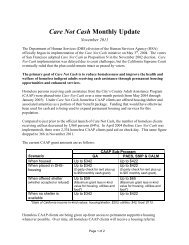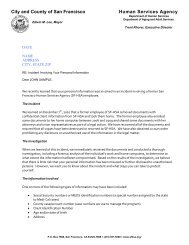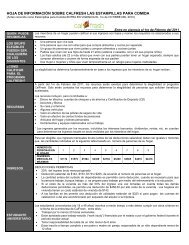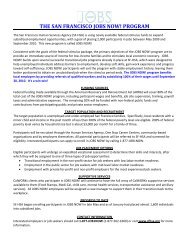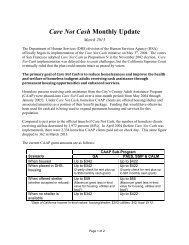May 21, 2012 - Human Services Agency of San Francisco
May 21, 2012 - Human Services Agency of San Francisco
May 21, 2012 - Human Services Agency of San Francisco
Create successful ePaper yourself
Turn your PDF publications into a flip-book with our unique Google optimized e-Paper software.
Long Term Care Integration (LTCI) Design Group<br />
Minutes from <strong>May</strong> <strong>21</strong>, <strong>2012</strong> Meeting<br />
Exploring the potential for LTCI in <strong>San</strong> <strong>Francisco</strong> and determining what is required to improve the<br />
provision <strong>of</strong> long term services and supports for Medi‐Cal eligible older adults & adults with disabilities<br />
Design Group Members Present:<br />
Tangerine Brigham ‐ Deputy Director, Department <strong>of</strong> Public Health; CO‐CHAIR<br />
Anne Hinton, ‐ Executive Director, Department <strong>of</strong> Aging and Adult <strong>Services</strong><br />
Nina Maruyama – Officer, Compliance & Regulatory Affairs, <strong>San</strong> <strong>Francisco</strong> Health Plan<br />
Phil Arnold ‐ Deputy Director for Finance and Administration, <strong>San</strong> <strong>Francisco</strong> <strong>Human</strong> <strong>Services</strong> <strong>Agency</strong><br />
Betty Fung – Director <strong>of</strong> Programs, Self‐Help for the Elderly<br />
Rebecca Malberg – Director, Home Care Division, SEIU – UHW<br />
Donna Calame ‐ Executive Director, IHSS Public Authority, at large position<br />
Margaret Baran – Executive Director, IHSS Consortium, at large position<br />
Herb Levine – prior Executive Director <strong>of</strong> ILRC, and disability consumer advocate<br />
Cindy Kaufman – Vice President, Institute on Aging, community services representative<br />
Sean Atha ‐ Director, Regional Field Operations, Anthem Blue Cross<br />
Design Group Members Absent:<br />
Eileen Kunz – Director <strong>of</strong> Policy, Regulatory Affairs & Compliance, On Lok Senior Health, CO‐CHAIR<br />
Melissa Howard – Fiscal and Policy Analyst, <strong>May</strong>or’s Office <strong>of</strong> Public Policy and Finance<br />
Alternates Present:<br />
Kelly Hiramoto – Director <strong>of</strong> Placement, Department <strong>of</strong> Public Health (alternate for Tangerine Brigham)<br />
Sarah Crow – Senior Planning Analyst, <strong>Human</strong> <strong>Services</strong> <strong>Agency</strong><br />
Shireen McSpadden – Deputy Director, Department <strong>of</strong> Aging and Adult <strong>Services</strong><br />
Renee Willette – Deputy Director <strong>of</strong> Legislative & Government Affairs, City & County <strong>of</strong> <strong>San</strong> <strong>Francisco</strong><br />
Department <strong>of</strong> Aging and Adult <strong>Services</strong> Present:<br />
Bill Haskell – Long Term Care Principal Investigator<br />
Linda Edelstein – Long‐Term Care Operations Director<br />
Megan Elliott – In‐Home Support <strong>Services</strong><br />
Carrie Wong – Adult Protective <strong>Services</strong><br />
Denise Cheung – Office on the Aging & County Veterans <strong>Services</strong><br />
Guests Present:<br />
Cathy Spensley – Senior Division Director, Family Service <strong>Agency</strong> <strong>of</strong> <strong>San</strong> <strong>Francisco</strong><br />
<strong>San</strong>dy Mori – Retired Development Director, Kimochi, Inc.<br />
Libby Denebeim – Retired CPMC Board <strong>of</strong> Trustees<br />
LTCI Consultants Present:<br />
David Nolan ‐ Principal, Chi Partners<br />
Lisa O’Connell ‐ Chi Partners<br />
1
MINUTES<br />
MAY <strong>21</strong>, <strong>2012</strong><br />
Meeting began at 1:10 p.m.<br />
1. Approval <strong>of</strong> April 16, <strong>2012</strong> Minutes<br />
The Design Group approved the April 16, <strong>2012</strong> minutes.<br />
2. Subcommittee Reports<br />
a. Finance Subcommittee – Phil Arnold informed the Design Group that the Finance Committee<br />
met on <strong>May</strong> 4, <strong>2012</strong> and presentations were made regarding the two health plans, On Lok and<br />
the rate structure including a description <strong>of</strong> capitation rates. Concerns were expressed about<br />
actions being taken by the State <strong>of</strong> California to pass on their budget cuts to the insurance<br />
companies. Nina Maruyama also discussed the State’s carve outs for long‐term care.<br />
Tangerine Brigham and Nina Maruyama then discussed the” risk corridor,” and the need to<br />
ensure that the State <strong>of</strong> California will make the health plan whole at the end <strong>of</strong> the year if their<br />
costs go up over a certain amount.<br />
Phil Arnold said that at the next meeting <strong>of</strong> the Finance Subcommittee they will discuss data<br />
measurement and what constitutes successful measurement. Herb Levine then talked about<br />
measuring the percentage <strong>of</strong> the population which remains in the community and not in nursing<br />
homes as a measure <strong>of</strong> success <strong>of</strong> managed care.<br />
b. Scope <strong>of</strong> <strong>Services</strong> Subcommittee ‐ Megan Elliott mentioned that the Scope <strong>of</strong> <strong>Services</strong><br />
Subcommittee discussed how to create the ideal system for consumers. They will meet this<br />
Wednesday, and have narrowed their focus regarding which services will be discussed.<br />
Phil Arnolds suggested that the Scope <strong>of</strong> <strong>Services</strong> Subcommittee discuss what services should be<br />
included in managed care. Megan Elliott stated that they will be discussing this issue.<br />
c. Communications Subcommittee – Herb Levine stated that the Communications Subcommittee<br />
discussed their scope <strong>of</strong> work at the first meeting. Their goal is to put together a<br />
communications plan including deciding what messages would be drafted and at what time it<br />
should be released. The subcommittee will make recommendations to the Design Group. The<br />
Communications Subcommittee will assemble background information on the SF LTCI. A<br />
communications plan has been drafted and will be revised as needed.<br />
The Subcommittee has also started to assemble a list <strong>of</strong> key organizations that will receive<br />
information from the Communications Subcommittee and then contact their members. When<br />
managed care plans communicate with their members, their communications must be approved<br />
2
first by the State <strong>of</strong> California. The subcommittee will not be communicating through managed<br />
care plans. Instead, they will be developing key talking points.<br />
Tangerine Brigham suggested that the Communications Subcommittee use focus groups to test<br />
materials and see if the public can understand the information being presented. Herb Levine<br />
said that they would be testing the information for clarity.<br />
3. Planning Memo for Design Group Meetings<br />
David Nolan explained that topics for upcoming Design Group meetings need to be calendared to ensure<br />
that all subjects are covered . He provided a memo detailing the subjects <strong>of</strong> the upcoming Design Group<br />
meetings. He then asked if any topics were missing and whether the order <strong>of</strong> the topics should be<br />
changed.<br />
Tangerine Brigham suggested that a column be added to the memo indicating which subcommittee will<br />
contribute to the discussion <strong>of</strong> that topic. This information will assist the subcommittee members in<br />
knowing when their deliverables are due.<br />
David Nolan introduced Lisa O’Connell, a member <strong>of</strong> Chi Partners, who will be mapping care<br />
coordination in Alameda and SF counties.<br />
David Nolan then stated that one <strong>of</strong> the goals <strong>of</strong> the Design Group is to define the target population, and<br />
this population will be discussed at the July 16 th meeting. Rebecca Malberg added that we should<br />
discuss the State <strong>of</strong> California’s healthcare budget at the July meeting as well. Tangerine Brigham noted<br />
that the Design Group needed an update on where the Governor and the legislature were headed on<br />
the budget.<br />
Anne Hinton mentioned that the October 15 th meeting should discuss how to link the relevant data<br />
being collected and used by various organizations and health plans. The October meeting <strong>of</strong> the Design<br />
Group should also discuss how health plans communicate with their contractors and how quality<br />
assurance data is collected. Tangerine Brigham added that the data should allow population based<br />
planning. Bill Haskell noted that <strong>San</strong> Mateo County is using predicative modeling data, and looking at<br />
the purpose <strong>of</strong> data to determine who uses the community services and who uses hospitals the most.<br />
Herb Levine asked if some providers are not able to collect the data, what is the impact on the<br />
consumers and the LTCI process. Nina Maruyama added that data should be collected on stateprovided<br />
services in order to improve those services.<br />
Phil Arnold suggested that the Design Group meeting on the topic <strong>of</strong> In‐Home Supportive <strong>Services</strong> (IHSS)<br />
should occur earlier. Megan Elliott stated that it doesn’t matter when we discuss IHSS, but the universal<br />
assessment tool needs to be discussed before we discuss IHSS.<br />
Tangerine Brigham discussed the fact that the State <strong>of</strong> California is considering reducing the amount <strong>of</strong><br />
reimbursement to family caregivers in IHSS. Megan Elliott noted that we don’t know the Governor’s<br />
final plans regarding IHSS.<br />
3
Rebecca Malberg commented that we need to use all <strong>of</strong> our resources as the incidence <strong>of</strong> chronic<br />
disease is greatly increasing in SF. Tangerine Brigham remarked that there needs to be a transfer <strong>of</strong><br />
care, and a decrease in the use <strong>of</strong> emergency rooms and urgent care centers for non‐urgent care. We<br />
need to place acute care recipients in the community and get them out <strong>of</strong> the hospitals. Savings will<br />
come from managed care, managing the acute care population, and not reducing their hospitalization.<br />
Tangerine Brigham also suggested that Ron Smith be contacted and invited to attend a Design Group<br />
meeting on behalf <strong>of</strong> the Hospital Council.<br />
4. Update on IHSS and LTSS Work Groups (DHCS)<br />
Megan Elliott provided an update on In‐Home Supportive <strong>Services</strong> and Long Term <strong>Services</strong> and Supports<br />
Work Groups. She explained that the California Duals project has a variety <strong>of</strong> subcommittees, and that<br />
she has attended the long term services and supports meetings. At these LTSS meetings, they discussed:<br />
approaches to network capacity and network quality, how to establish readiness, the standards for a<br />
medical network, the required number <strong>of</strong> providers, operational readiness, financial stability, customer<br />
service, the ability <strong>of</strong> providers to submit bills and obtain reimbursement, challenges for defining LTSS<br />
network adequacy, and the fact that there is no federal standard for LTSS network adequacy. At the<br />
LTSS meetings, they also covered geographic challenges.<br />
Rebecca Malberg asked how we educate people about the services available. Megan Elliott explained<br />
that under managed care, county social workers will work with managed care plans and participate on<br />
care coordination teams. Managed care providers, county social workers and care‐coordination teams<br />
will advise recipients <strong>of</strong> the services available. The teams will be used as needed for complex care cases<br />
to assist in an overall plan that will improve health outcomes. In addition, it would be the recipient’s<br />
choice to have a care team, if they want to participate on the team, and if they want their IHSS provider<br />
on the team.<br />
Megan Elliott also pointed out that IHSS recommended: the implementation <strong>of</strong> readiness criteria,<br />
guidelines for creating the care coordination teams and creating a care assessment tool, and the<br />
development <strong>of</strong> a home and community‐based care assessment tool which will be used by all programs<br />
for dual eligibles. She also explained that the database that IHSS runs is called CMIPS. In addition, IHSS<br />
is developing a universal assessment tool along with its development <strong>of</strong> CMIPS2 (the database under<br />
development). In 2015, a coordinated care initiative will consider transitioning to a universal<br />
assessment tool which will be used by all counties. While there is a functional ranking <strong>of</strong> recipients to<br />
determine their eligibility for IHSS services, there is no state‐wide universal assessment tool to<br />
determine their needs for home care and transportation for example. The goal <strong>of</strong> IHSS is to have statewide<br />
uniformity in the assessment <strong>of</strong> recipients needs with a universal assessment tool.<br />
Rebecca Malberg commented that county social workers need to use the same assessment tools. Then<br />
if it is necessary for the number <strong>of</strong> care hours to be increased in order for the recipient to remain in the<br />
community; the assessment tool will indicate the need for those increased hours <strong>of</strong> care.<br />
Megan Elliott further commented that IHSS has said, that the number <strong>of</strong> hours <strong>of</strong> home care cannot be<br />
decreased by the health plans, but only increased so as to avoid recipients’ hospitalizations.<br />
4
Furthermore, in <strong>San</strong> Mateo County, when a recipient enters the health plan and is a high risk recipient,<br />
they should be given a risk assessment. The recipient can then decide if they want care coordination as<br />
they have been deemed to be high risk.<br />
<strong>May</strong> Budget Review<br />
A review <strong>of</strong> the State <strong>of</strong> California’s budget was tabled by Tangerine Brigham.<br />
5. Alameda Alliance for Health Meeting<br />
DAAS staff met with key staff <strong>of</strong> the Alameda Alliance for Health, one <strong>of</strong> the two health plans in Alameda<br />
County. While Alameda is currently a two‐plan model, it is exploring becoming a county organized<br />
health system. Alameda Alliance and SF LTCI have agreed to meet regularly to share information and<br />
lessons learned as both are part <strong>of</strong> DAAS’s SCAN proposal. These meeting will occur quarterly.<br />
Chart <strong>of</strong> Long‐Term <strong>Services</strong> and Supports<br />
Tangerine Brigham briefly discussed the chart <strong>of</strong> Long‐Term <strong>Services</strong> and Supports and Specific State<br />
Plan <strong>Services</strong> for Medi‐Cal Dual Eligibles which was provided to the Design Group. The chart detailed<br />
the type <strong>of</strong> services provided and the average number <strong>of</strong> monthly users per county in California for each<br />
type <strong>of</strong> service. The data covers dates <strong>of</strong> service from January 2010 through December 2010. The chart<br />
will be available for viewing at: www.sfdaas.org.<br />
Next Meeting <strong>of</strong> the LTCI Design Group<br />
The next meeting <strong>of</strong> the Design Group will be on June 18, <strong>2012</strong> at 1:00 p.m.<br />
The meeting adjourned at 3:00 p.m.<br />
5



